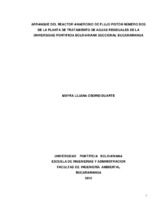| dc.contributor.advisor | Cajigas Cerón, Álvaro Andrés | |
| dc.contributor.author | Osorio Duarte, Mayra Liliana | |
| dc.coverage.spatial | Seccional Bucaramanga. Universidad Pontificia Bolivariana. Escuela de Ingenierías. Facultad de Ingeniería Ambiental | spa |
| dc.coverage.temporal | 2010 | |
| dc.date.accessioned | 2013-08-28T16:59:53Z | |
| dc.date.available | 2013-08-28T16:59:53Z | |
| dc.date.created | 2010-12-16 | |
| dc.date.issued | 2013-08-28 | |
| dc.identifier.uri | http://hdl.handle.net/20.500.11912/1016 | |
| dc.description | 108p.: (pdf); il; gráficas; tablas; anexos | spa |
| dc.description.abstract | Desde el inicio del funcionamiento de la PTAR (1998), entró en ejecución el reactor No. 1 de lunes a viernes, es decir, durante la jornada académica, en cuanto al manejo de las aguas de lavado producidas en los fines de semana, eran desviadas hacia el reactor No.2, para no afectar el tratamiento. Éste proyecto coloca en marcha el RAP No 2 de manera simultánea para así aumentar la capacidad del tratamiento y obtener mejores resultados, en términos de remoción de materia orgánica (MO), sólidos totales (ST), estabilización de efecto Buffer y control de pH, en el efluente del tratamiento secundario. Como objetivo general se planteo: Llevar a cabo el arranque del Reactor Anaerobio de Flujo a Pistón número dos de la Planta de Tratamiento de Aguas Residuales de la Universidad Pontificia Bolivariana seccional Bucaramanga; determinando eficiencias para diferentes cargas hidráulicas. El desarrollo de este proyecto se dividió en tres etapas, caracterización del sustrato, adaptación del lodo existente y arranque del RAP. Finalmente Los resultados obtenidos en el estudio, muestran que el reactor número dos se encuentra apto para tratar aguas residuales de la universidad siempre y cuando se mantenga estable el caudal de entrada de las aguas residuales con un TRH de 14 horas, para obtener remociones superiores al 70%. La última prueba en el laboratorio se realizó el día 98, y se ha cumplido con el cronograma de actividades obteniendo resultados óptimos en términos de remoción de MO, control de pH, producción de A.G.V’s y estabilidad general del reactor. Esto demuestra que un tratamiento de aguas residuales de tipo anaeróbico se empieza a estabilizar en el rango de 80 a 180 días desde el arranque del mismo tal cual como está definido en las diferentes literaturas que hacen referencia al tema en estudio. | spa |
| dc.description.abstract | Since the start of operation of the PTAR (1998), entered into execution the No 1 reactor that operates from Monday to Friday, during academy day, regarding the handling of wash water produced in the weekends, were diverted into reactor No.2, not to affect treatment. This project puts in place the RAP No 2 simultaneously in order to increase treatment capacity and better results, in terms of organic matter removal (MO), total solids (TS), stabilization buffer effect and pH control in the secondary effluent. The main objective was posing: Carry out the start of the anaerobic reactor number Two Piston Plant Wastewater Treatment of the Universidad Pontificia Bolivariana Bucaramanga; determining efficiencies different hydraulic loadings. The development of this project was divided into three stages, Substrate characterization, adaptation of existing sludge and boot RAP. Finally The results of the study show that the reactor number two is suitable for treating wastewater University as long as it remains stable inflow of sewage of the university TRH of hours, removals for over 70%. The last test in the laboratory took place the day 98, and has complied with the schedule of activities obtaining optimal results in terms of removal MO, PH control, A.G.V´s production and stability of the reactor. This shows that a wastewater treatment anaerobic rate begins to stabilize in the range of 80 to 180 days from the start of it as is as defined in the various literatures that relate to the topic under study. | |
| dc.language.iso | es | |
| dc.publisher | Universidad Pontificia Bolivariana | spa |
| dc.rights | Attribution-NonCommercial-NoDerivatives 4.0 International | * |
| dc.rights.uri | http://creativecommons.org/licenses/by-nc-nd/4.0/ | * |
| dc.subject | Ingeniería ambiental | spa |
| dc.subject | Tesis y disertaciones académicas | spa |
| dc.subject | Universidad Pontificia Bolivariana | spa |
| dc.subject | Agua - purificación | spa |
| dc.subject | Aguas residuales | spa |
| dc.title | Arranque del reactor anaerobio de flujo pistón número dos de la planta de tratamiento de aguas residuales de la Universidad Pontificia Bolivariana Seccional Bucaramanga | spa |
| dc.type | bacherlorThesis | spa |
| dc.rights.accessRights | openAccess | spa |
| dc.type.hasVersion | publishedVersion | spa |
| dc.identifier.instname | instname:Universidad Pontificia Bolivariana | spa |
| dc.identifier.reponame | reponame:Repositorio Institucional de la Universidad Pontificia Bolivariana | spa |
| dc.identifier.repourl | repourl:https://repository.unab.edu.co/ | |


